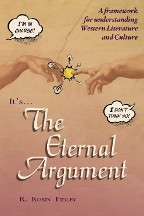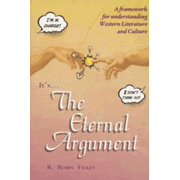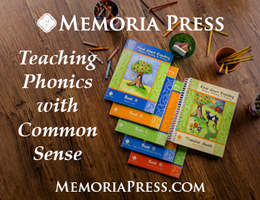In The Eternal Argument, R. Robin Finley presents a relatively simple framework for understanding both Western literature and culture. The book is first of all a guide for anyone teaching literature to teens. It helps the teacher to raise questions and lead discussion in such a way that students learn to read beyond the surface of the story and identify the worldview being presented through the literature.
The Eternal Argument also serves well as an entry point for understanding and teaching worldviews. It reduces worldviews down to the simplest level with two contenders: One says, “There is a God and He rules over a flawed mankind by giving us rules by which to live.” Finley calls this the Theistic side. Opposing this worldview is what she calls the Humanistic view: “There is no God so people decide what’s good and what’s evil, and human nature can arrive at the rules” (p.3). Finley acknowledges that she uses the terms Theism and Humanism in a specialized way but does so for want of better words to represent these two viewpoints. And this works just fine in my opinion.
Finley explains the Eternal Argument in the introduction. The bulk of the book—chapters 1 through 13—was written for parents or teachers to read aloud and discuss with students. It’s very well written. Finley uses personal anecdotes along with illustrations from literature to keeps things interesting. Each of these chapters concludes with useful discussion questions. To make it even more convenient, the publisher also offers an audio book version of the program, or a bundle that includes both versions.
In the first chapter, she explains how literature provides a ready platform for presenting the Eternal Argument as a “unifying thread” that helps readers make sense of literature as well as culture of both the past and present. She then takes a few chapters to discuss key elements of the opposing views, ideas about sin and the nature of man as well as the source of morality. While Finley is a theist, she does not take a theist viewpoint in her book. Humanists can use it as readily as can Theists. She stresses the importance of exposing students to literature that presents worldviews with which we disagree so that students can both identify worldviews and be familiar with their underlying assumptions and beliefs. Otherwise, you have situations where a student (usually a Christian) goes to college and is suddenly exposed to a whole new world of ideas that challenges everything he’s been taught, and he has no framework or “tools” for examining those ideas.
Finley claims that Western literature is built upon a platform of three literary strands that provide students with cultural literacy: Greek and Roman mythology, the King James Version of the Bible, and Arthurian legends. (The latter is much less significant than the first two strands.) Because of this, she strongly recommends that students include reading from all three strands. She recommends particular sources for the first strand that are appropriate for different age levels.
Shifting gears, Finley devotes five chapters to a chronological journey through literary periods to demonstrate the Eternal Argument in action. She highlights one representative piece of well-known literature for each era she addresses, showing how it can be used as an exemplar to begin to examine questions related to the Eternal Argument. You can stop and read the suggested pieces of literature as you work through the chapters or you can return to them after reading the rest of the book. (The book is indexed so it will be easy to find what you want at a later date.) Finley offers suggestions for excerpts from some of the lengthier works like Don Quixote (especially excerpts found in the various Norton Anthologies since they are easily found in used editions at low cost). So even if you don’t have time to read the complete works, both you and your students can still learn how these particular literary works relate to the Eternal Argument.
One basic graphic is used throughout much of the book. It’s a simple chart with Humanism and Theism in the top left and right corners respectively. Then it shows how the literary and cultural pendulum has swung back and forth between the two views over the centuries, even moving away from both views in recent times. The visual aid is simple but effective as Finley adds to the pendulum swings as she moves through the historical chapters. You might even want to print out the chart on page 179 to keep handy for reference for future literary studies since it adds notations to the pendulum swings showing key people and events that mark the turning points. The pendulum chart is included as an insert with the audio version of The Eternal Argument since it is so important.
Parents and teachers need to be sure to read chapters 14 and 15 on their own before trying to teach the recommended literary works. Chapter 14 expands on Finley’s treatment of each literary work that she discusses through the “historical” chapters, suggesting important discussion questions and key points to consider. Chapter 15 adds some personal insights for each chapter, some of which should be very helpful.
You can read the introduction and chapter one free on line at www.eternalargument.com/SampleChapters.html.
The beauty of this book, in my opinion, is that it takes a really big idea—the Eternal Argument—and presents it simply and clearly enough that even the novice homeschooler can use it. She can read the book with one or more of her teens, learning right along with them. And it's also a great read for adults who just want to learn about the Eternal Argument for themselves.












